Islamophobic incidents in Australia have more than doubled in the past two years, with girls and women disproportionately targeted, new research shows.
Girls and women accounted for three quarters of all incidents, including physical attacks, verbal harassment and rape threats, and they were a third more likely to be physically attacked than boys and men.
These alarming statistics have emerged from the fifth Islamophobia in Australia report, looking at incidents between January 2023 and December 2024.
The report shows 309 in-person incidents occurred during this time period, which is a more than 2.5-fold increase from the previous reporting period. When it comes to verified online incidents, there were 366 incidents, more than triple the previous year.
Similar to previous reports, gender was a prominent feature of Islamophobic incidents, with women reporting more than three times the number of Islamophobic incidents at workplaces than men. This is particularly significant given Muslim women are underemployed compared to Muslim men in Australia.
In other locations where Islamophobic incidents occurred, it was girls and women who were more often targeted as well.
Girls and women made up 95 per cent of the victims of reported incidents on public transport, 74 per cent of victims at shots and 83 per cent of victims on the street, parking or driving. They were also 100 per cent of the victims of spitting incidents, either as the only victim (71 per cent) or as a victim alongside a male victim (29 per cent).
“This is the tenth consecutive year of reporting on Islamophobia in Australia that has demonstrated that Muslim women and girls are specifically, overwhelmingly the victims of these incidents, and the perpetrators are generally men. We recommend this practice be considered within a gender-based abuse framework,” said lead researcher Dr Susan Carland.
In one instance, girls and women were specifically targeted in a threat at a Muslim school, where the perpetrator called the school and said he would specifically target schoolgirls who wore the hijab with a knife.
One female Muslim respondent told the report: “I started wearing the hijab at the start of this year and ever since I’ve been experiencing racist jokes and comments from other students, like, ‘towel head’, ‘bomber’, ‘9/11’, ‘Taliban’, ‘stupid hijab bitch’, and I have had pork thrown at me.”
The only place where male Muslims had a higher proportion and raw number of Islamophobic incidents compared to female Muslims was at school.
The report shares a number of disturbing first-hand experiences from Muslim respondents, with another saying: “When walking into train station, a man said to me ‘I’ll rip that scarf off your head and smash your head and rape you.”
Yet another said: “A man told me as I was walking along the beach, ‘I would like to take you for a shag in the bush and throw you over the edge of the cliff’. He also said ‘what is that on your head?’ about my hijab.”
Looking towards change, the report shares a number of recommendations aimed at putting an end to Islamophobic incidents in Australia.
One key recommendation given is for law enforcement agencies and federal, state and local governments to “recognise and address Islamophobia as a gendered issue” and “incorporate it into gender-based abuse and violence frameworks”.
Having founded the Islamophobia Register Australia in 2014, Mariam Veiszadeh reflects on the latest publication, saying it comes amid a “backdrop of an unprecedented surge in Islamophobic incidents across our nation”.
“The academic team, led by the talented Dr Susan Carland, has done an exceptional job elevating the analysis in this report, which covers a period marked by the highest number of incidents since our inception.”
“This alarming rise is largely driven by Anti-Palestinian racism, with Dr Naser Alziyadat providing critical insights in the dedicated chapter on this issue.”
The report shows there was a spike in incidents in the three weeks after the Hamas attacks on Israel on 7 October 2023 and during the subsequent war in Gaza. There was a 1,300 per cent increase in reports to the register during that period compared to the same time the previous year.
“This report provides clear evidence that Islamophobia is not only real but poses a significant threat to the safety, wellbeing, and fundamental rights of Australian Muslims, which inevitably impacts on feelings of safety and community for all Australians,” the authors write.
“The question is no longer whether Islamophobia exists, but what we as a society will do to combat it. Politicians, media organisations, and community leaders must move beyond acknowledgement to meaningful action.”


